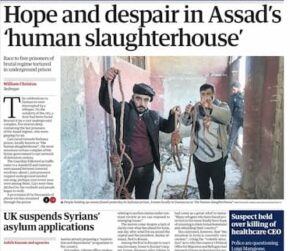This is a difficult subject for me to cover, for several reasons. But I think it really needs to be examined.
But this is about the media’s singular focus on Sednaya – and why this has been made into the central or defining element of this ‘liberation of Syria’.
Also, the foreign media reporting in Syria is embedded with the rebels and is therefore participating in the rebels’ own PR exercises: the prison liberation being a central part of that – along with the horrific stories.
This is where the hypocrisy over Sednaya becomes all the more troublesome: because Sednaya Prison itself was used as a black site for extraordinary rendition during the War on Terror!

The level of either cognitive dissonance or deliberate dishonesty is not even surprising at this point, but it’s still disturbing.
Any regime that carries out such abuses of prisoners fully deserves to be exposed for it – and to carry the stain of it forever.
In which case, it’s primarily a propaganda exercise: not an honest human rights issue.
At any rate, don’t be fooled by the media’s apparent outrage over the treatment of prisoners in Syria.
It isn’t being driven by any kind of compassion or morality. It is political, and entirely cynically motivated.
_________________
If you value journalism of this kind and wish to see more articles like this, consider supporting this blog with either a one-time or regular donation (of any amount) via Paypal. With enough support, more time, energy and resources can be devoted to content like this.
_________________





Great Piece…Fuck Israel